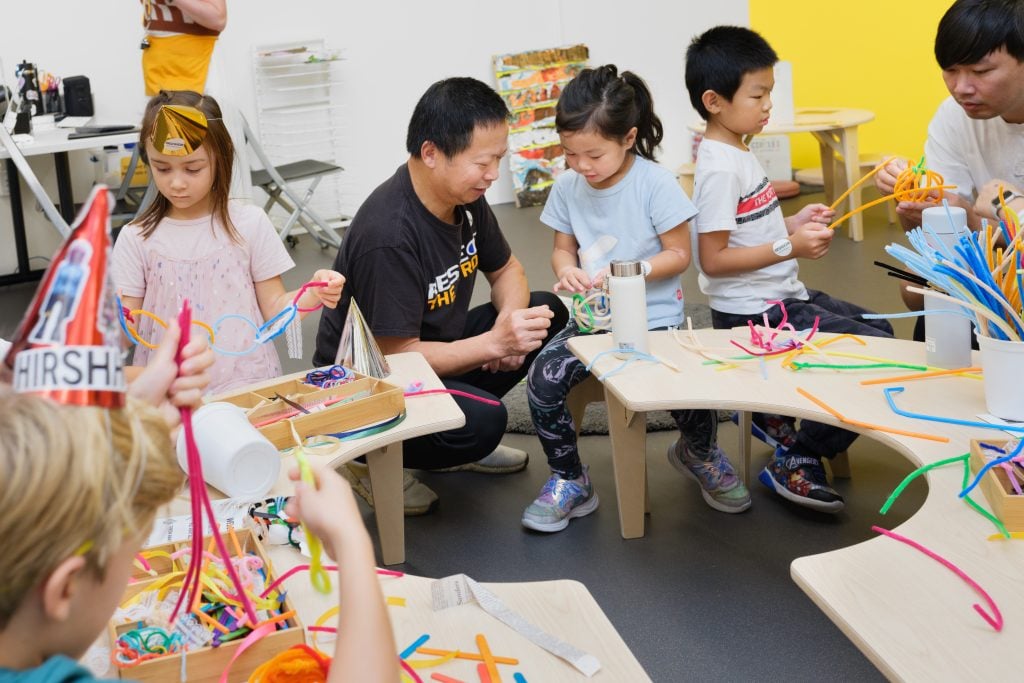
29 Oct The Hirshhorn Museum Is Looking to the Future With a New Art School
Source Credit: Content and images from Artnet News. Read the original article - https://news.artnet.com/art-world/hirshhorn-art-school-2559859
When it first opened in 1974, the Hirshhorn Museum and Sculpture Garden was an outlier on Washington, D.C.’s Independence Avenue. The cement donut-shaped building, designed by Gordon Bunshaft, was the first modernist outfit on the largely neoclassical National Mall. It was deemed unusual, unwelcoming, and unsightly by both Congress members and art critics. Moreover, the museum’s eccentricity—and to some extent that of its benefactor, avid contemporary art collector Joseph H. Hirshhorn—kept it from arriving at a cohesive identity for its first couple of decades as curators struggled with its curved walls and an unusual abundance of Henry Moore sculptures.
Since then, and especially within the last decade, the Hirshhorn has hit its stride, becoming one of the leading institutions for Modern and contemporary art in the U.S. Now, the museum is looking to further its legacy for the next 50 years by bulking up its educational programming alongside its growing collection and wide-ranging exhibitions.
Among these initiatives is a new art school, opening to the public on October 30. The 1,700-square-foot complex, housed within the museum, will welcome visitors of all ages, with semester-long courses for kids and public programs and open studios for adults led by dedicated museum educators and teaching artists. Students will delve into art from the maker’s perspective, learning about their biographies, processes, and guiding philosophies. The first semester, titled “Boundary Breakers,” focuses on modernist pioneers like Anni Albers and Barbara Hepworth as well as leading contemporaries like Mark Bradford.

Caretakers and children make art in Hirshhorn Art School. Photo: Rick Coulby. Courtesy of the Hirshhorn Museum and
Sculpture Garden.
“When the Hirshhorn opened in 1974, museum education was in its infancy and largely grounded in observation,” said the museum’s director Melissa Chiu. “We’ve since found that experiential art learning is both highly effective and in demand. Since 2019, the museum has engaged more than 53,000 visitors in person and more than 170,000 online with free art education programs.”
These numbers are set to jump, with the museum expecting to host more than 25,000 visitors to its 1,700-square-foot art school in the inaugural year alone, with 75,000 more attending online.

View of the Hirshhorn Museum and Sculpture Garden, Smithsonian Institution, Washington, D.C. Photo: Lee Stalsworth.
As the only free museum of Modern and contemporary art in the U.S., the museum’s holdings also provide a wealth of educational opportunities. The founding collection was a robust endowment of 6,000 artworks from Hirshhorn, an early supporter of midcentury giants like Willem de Kooning, Arshile Gorky, and Jackson Pollock. His taste is also notable for its emphasis on sculpture, including Moore, Giacometti, Auguste Rodin, and Alexander Calder. He donated a further 6,400 works upon his death in 1981.
A product of its time, the core collection skewed white and male—but that has certainly started to change. In the last five years, the museum has focused on its acquisitions of contemporary art in an effort to further its mission of “radical accessibility,” a term that not only applies to infrastructure updates amid a recent renovation but also the diversity of its art so that all visitors feel welcome. To that end, the museum has added works by Indigenous sculptor Rose B. Simpson, Palestinian-Saudi artist Dana Awartani, and South African photographer Zanele Muholi. Last year alone, it purchased 80 works by the likes of Nam June Paik, Dawoud Bey, Cindy Sherman, Dyani White Hawk, Wangechi Mutu, and Guadalupe Maravilla.

Installation view of “Revolutions: Art From The Hirshhorn Collection, 1860–1960.” Photo: Rick Coulby, courtesy of Hirshhorn Museum and Sculpture Garden.
The Hirshhorn became a must-see destination for visitors from around the U.S. and the globe with its sprawling Yayoi Kusama exhibition that remained on view for more than a year due to popular demand, finally closing in the summer of 2023 after multiple extensions. Yet its anniversary exhibition, “Revolutions,” on view through April 20, 2025, better underscores the new course it is charting. At the entrance are two portraits: John Singer Sargent’s typically magnificent Mrs. Kate A. Moore (1884) beside the much more recent acquisition of Ghanaian artist Amoaka Boafo’s Cobalt Blue Dress (2020). Together, they chart over a century of radical change while also revealing a more timeless sensibility.
The rest of the survey unfolds more or less chronologically. First it maps out the century 1860–1960 with standout paintings by 126 artists like Francis Bacon, Jean Dubuffet, and George O’Keeffe. This display is peppered with works by the likes of Rashid Johnson and Flora Yukhnovich to show how these once radical innovations continue to influence artists today.

Hirshhorn Museum visitors stand in front of Jean-Michel Basquiat’s Boy and Dog in a Johnnypump (1982) in Basquiat x Banksy, on view through Oct. 26, 2025. Photo by Tony Powell for the Hirshhorn. All images by Jean-Michel Basquiat, all likenesses of Jean-Michel Basquiat, and all use of Jean-Michel Basquiat’s name © Estate of Jean-Michel Basquiat. Licensed by Artestar, New York.
The museum is also launching a year-long series of exhibitions that place two beloved artists’ in dialogue to reveal a lens on each practice. For the first edition, American artist Jean-Michel Basquiat goes head-to-head with anonymous British street artist Banksy.
The museum is also broadening its reach beyond its curved walls. With the launch of its new online video series “Studio Hirshhorn,” it will offer audiences a rare glimpse into the planning that goes into exhibition programming. The series debuted last month with nine short, social media-friendly videos documenting how the Brazilian artist duo OSGEMEOS prepared for their largest U.S. museum survey, which opened at the Hirshhorn on September 29.
Source Credit: Content and images from Artnet News. Read the original article - https://news.artnet.com/art-world/hirshhorn-art-school-2559859

